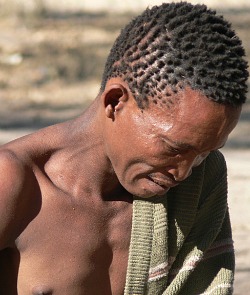 The Republic of Namibia is a country located at the southern part of Africa bordering the South Atlantic Ocean between the Republic of Angola and the People's Republic of South Africa. Although Namibia is a small country by population size, the Republic of Namibia covers a huge total land area of about 824,292sq.km (with about 1,002sq.km covered by water) and about 1,572km of coastline.
The Republic of Namibia is a country located at the southern part of Africa bordering the South Atlantic Ocean between the Republic of Angola and the People's Republic of South Africa. Although Namibia is a small country by population size, the Republic of Namibia covers a huge total land area of about 824,292sq.km (with about 1,002sq.km covered by water) and about 1,572km of coastline.
Namibia has a total population of about 2.2 million people with the population growth rate around 0.8%. About 38% of Namibia's population lives in urban areas in major cities and towns such as Windhoek the capital. Windhoek has a total population of about 350,000 people.
Despite its small population size, Namibia remains one of the most culturally rich countries in all of Africa with several different ethnic and racial groups living peacefully together.
The major racial groups living in Namibia today include black Africans who make up about 87% of the total population. Whites make up about 6% of the total population with mixed racial groups (black-white) forming about 6.5% of the total population.
The several ethnic groups living in Namibia today include the Ovambo tribe who make up about 50% of the total population, followed by the Kavangos who make up about 9% of the total population. Other ethnic groups include the Damara who make up about 7% of the total population, the Herero who make up about 7% of the total population, the Nama who make up about 5% of the total population. The Caprivian and the Bushmen make up about 4% and 3% of the total population respectively. Other minor groups include the Basters who make up about 2% of the total population and the Tswana who make up about 0.5% of the total population.
English remains the official language of Namibia although several other foreign and local languages are spoken in Namibia today. Afrikaans a major language is spoken by many including about 60% of the White population. German which is a foreign language is also spoken by about 32% of the population. Several indigenous languages including the Oshivambo, the Herero, and the Nama are all spoken by many. Christianity remains the most dominant religion in Namibia today with about 80-90% of the population being Christians (mostly Lutherans). Indigenous believers make up the remaining 10-20% of the population.
Namibia just like its neighboring countries is blessed with abundance of natural resources such as diamonds, gold, uranium (Namibia is the world's largest producer of uranium), copper, silver, lead, tin, lithium, cadmium, tungsten, zinc, salt, hydropower, fish, and some suspected deposits of oil, coal, and iron ore.
However, despite the abundance of natural resources, the Republic of Namibia remains one of the poorest countries in all of Africa with about 56% of its total population living below poverty line (live on less than $2 a day with majority living on less than $1.25 a day). Namibia's literacy rate is around 88.8% for the total population with the female literacy rate around 88.5%. In other words, about 88.5% of all females above the age 15 living in Namibia today can at least read and write which is far better than in most other African countries.
However, despite this 'good' literacy rate, about 43% of Namibians remain unemployed. Namibia's shaky economy depends heavily on mining which accounts for about 8% of GDP, but provides more than 50% of foreign exchange earnings. Meanwhile, the mining sector employs just about 3% of the population. The problem here is that, many students graduate from school with degrees but unable to get better jobs to do.
Another major reason is that, although the majority can read and write, quality education is something very hard to come by not just in Namibia but in almost all African countries today.
The Republic of Namibia has perhaps one of the worst climatic conditions in all of Africa. Namibia is mostly desert, hot and dry with rainfall very sparse and erratic. Prolonged periods of drought remain a major problem in Namibia today. This doesn't favor agriculture at all in most parts and in drought years, food shortages remain major problems especially in the rural areas. The Republic of Namibia normally imports about 50% of its cereal requirements. Limited natural freshwater resources, wildlife poaching, land degradation (gradual deterioration of the environment), desertification, etc. remain some of the major environmental issues facing Namibia today.
The Republic of Namibia remains one of the HIV/AIDS killing zones in Africa with a very high HIV/AIDS adult prevalence rate of 13.1%. In 2009, more than 180,000 of the population were living with HIV/AIDS with about 6,700 deaths recorded within the same year. Besides HIV/AIDs, the deadly malaria, bacterial diarrhea, typhoid fever, hepatitis A, schistosomiasis, etc. continue to threaten several lives in Namibia today.
Just like in most other African countries today, corruption and poor governance continue to tear Namibia apart. The few in the top (the greedy politicians) continue to enjoy while the average Namibians continue to die in silence.
